Case Study: How To Structure Your Site Using Keyword Cupid
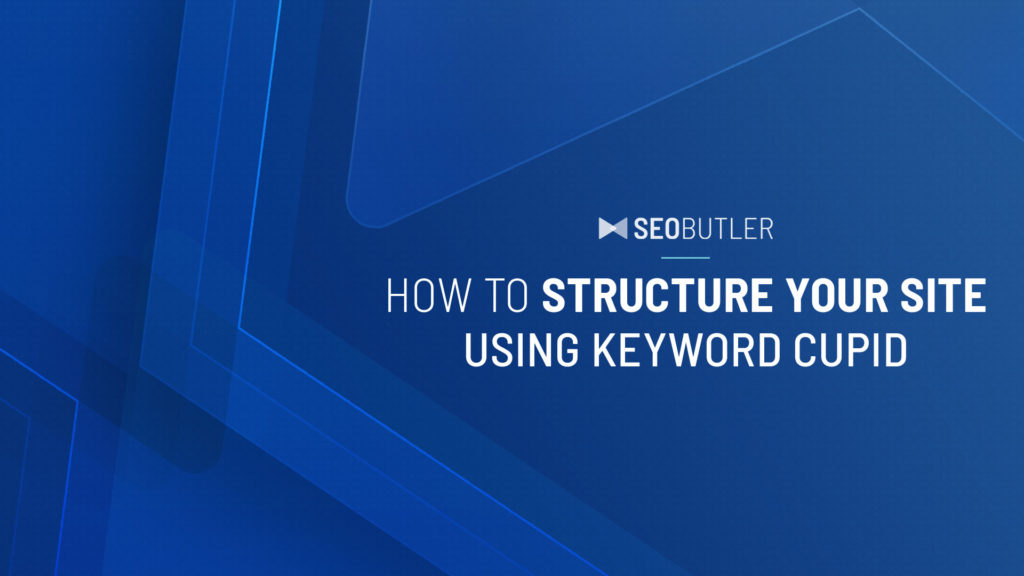
One of the first steps of keyword research is gathering a vast number of keywords you wish to target using one of the many tools available.
But once you’ve compiled your list, where do you go from there?
Do you manually sort your keywords into Silos based on your own knowledge of their relation to each other?
Do you follow one of the many guides to keyword research?
I encountered this fundamental SEO problem when trying to structure a site about probiotic skincare.
Skincare is a difficult niche because there are so many brands, types of products, and different skincare concerns.
On top of that, probiotic skincare is a relatively obscure niche in the beauty industry that not many people are highly informed on.
Basically, I couldn’t just look at a keyword list on this topic without a ton of manual research and know which keywords were related to each other.
That’s where Keyword Cupid (KC) became invaluable.
We developed Keyword Cupid to solve keyword research problems exactly like this for our own sites.
Not only were we looking to automate our manual research, but we wanted to stop relying on our intuition or arbitrary “rules” to group keywords together topically.
KC uses machine learning algorithms to cluster keywords based solely on Google search results.
Thanks to Google’s sophisticated Natural Language Processing (NLP), the results rival those of even the most seasoned SEO keyword research specialists (if not better).
Better yet, KC is completely automated.
Running the Keyword Cupid Report
For this case study, I automatically clustered and organized a list of 1,418 keywords related to probiotic skincare.
I’ll then highlight some key findings from this analysis and show you how you can apply these findings to your own sites.
Before I could do any clustering, I had to find the relevant keywords for my niche.
Rather than relying on one tool, I pulled from multiple different sources such as Ahrefs, SEMRush, and Google itself.
Then I structured my keyword list as a custom report with the volume, difficulty, and CPC of each keyword I wished to cluster.
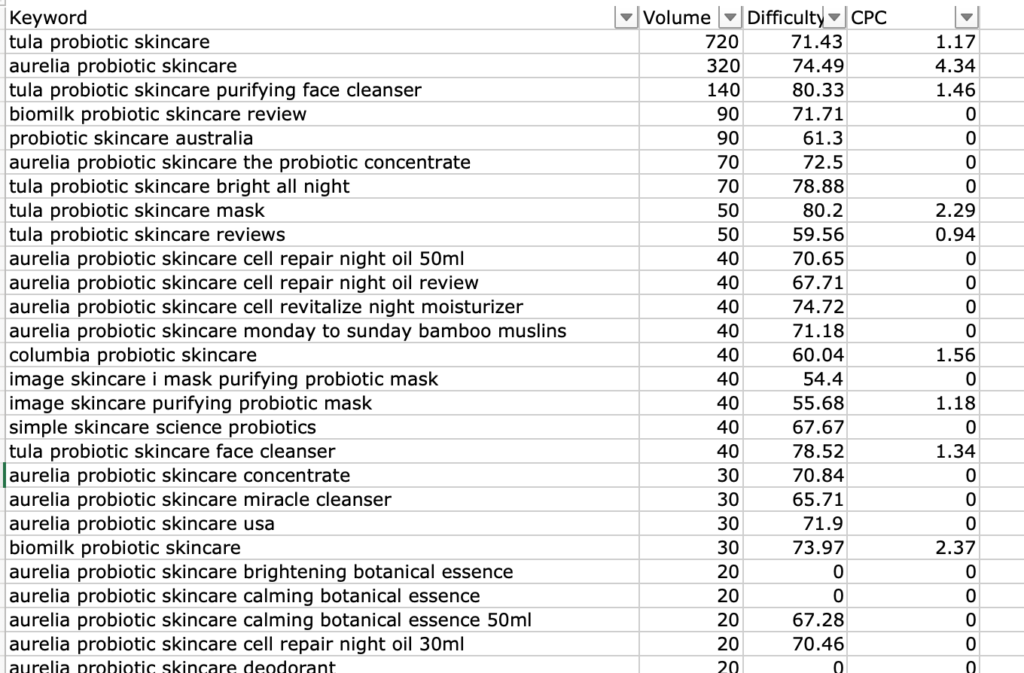
I then proceeded to run KC’s B.Y.O.D. (Bring Your Own Data) report in my Probiotic Skincare project.
I uploaded my keyword list as a Custom file and selected ‘All Metrics.’ I also specified the number of keywords I wanted to cluster.

When the report finished running, it returned a mindmap and an Excel report.

These reports show the same information in different ways. The mindmap is more useful for visualizing the multiple hierarchical levels of your keyword relationships and silo structures.
The Excel report is excellent for performing further analysis and passing along to team members.
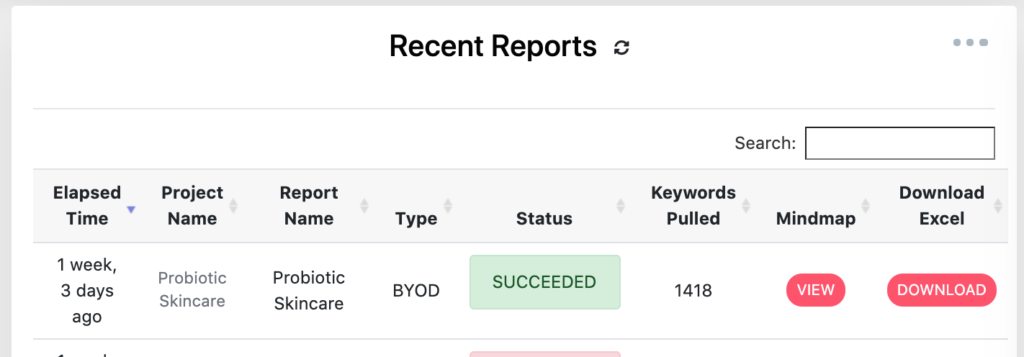
Both reports divide the keyword clusters into Big Silos, Small Silos, and Single keywords.
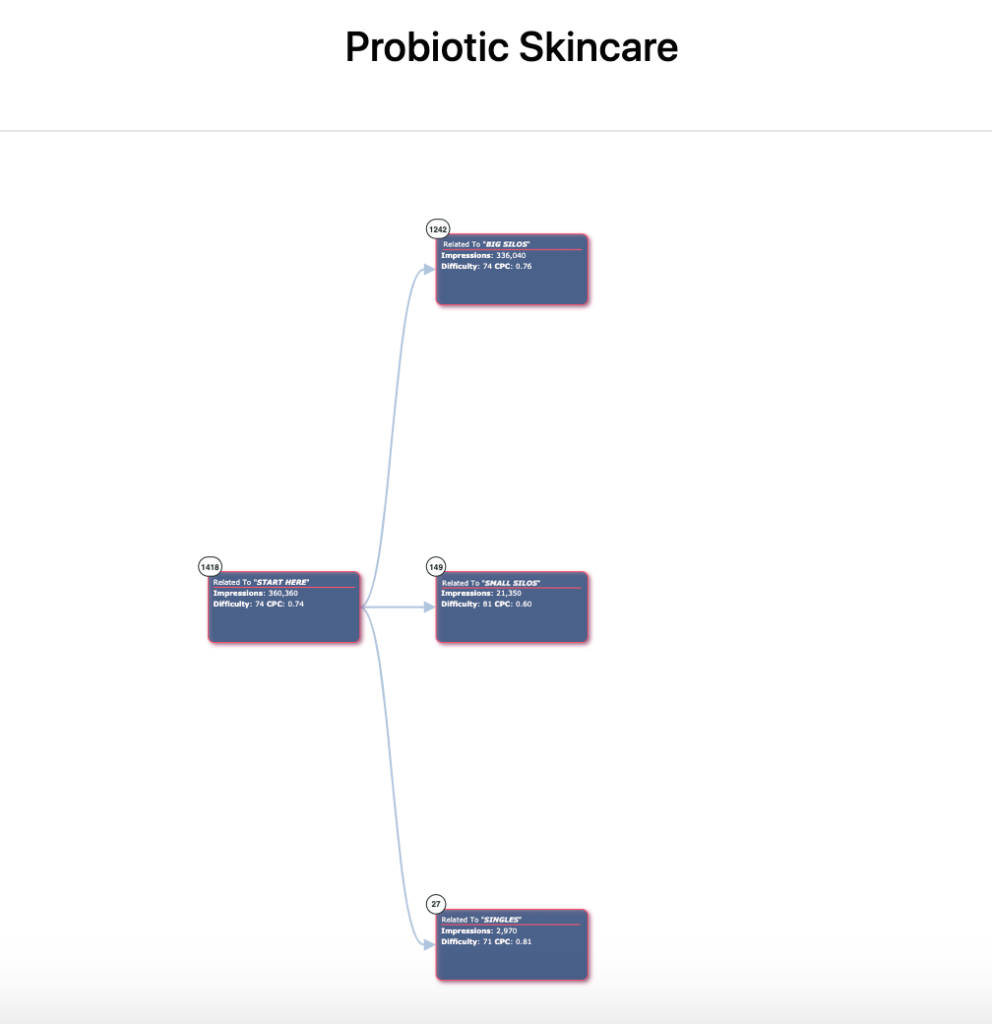
The Big Silos are the clusters that contain the most keywords, but the Small Silos can still have strong associations.
The difference is that the Small Silos contain a smaller number of keywords.
The Singles are most likely of little value to you because the algorithm could not match them with other keywords in your list.
You can see the keywords inside each cluster by clicking the nodes to drill down.
The Silos are at the top of a hierarchy of Silos, Page Themes, and then keywords.
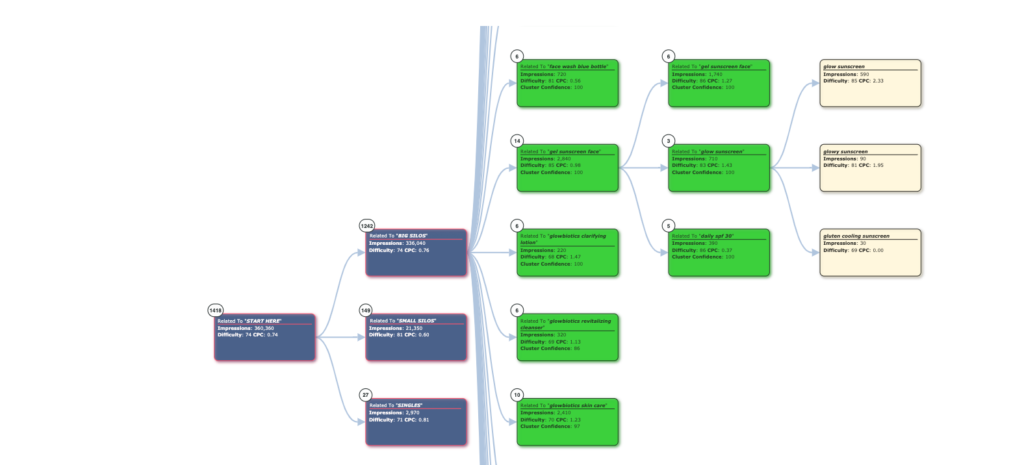
The Excel report serves a similar function but the Big Silos, Small Silos, and Singles are kept in different sheets, and you don’t need to expand the nodes to see the Silos and Page Themes.
The Excel format facilitates finding and sorting specific keywords.
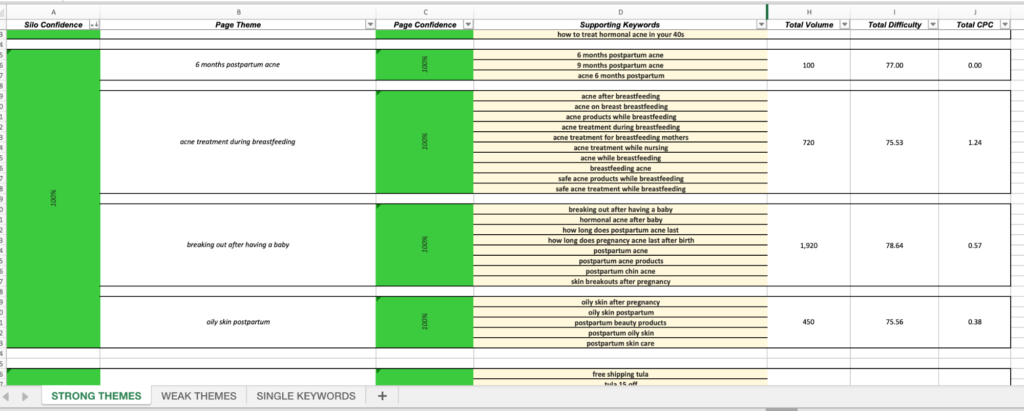
Page Themes and Silos in Keyword Cupid
Now that I’ve explained the basics of KC reporting, let’s get to the results!
I uploaded 1,418 keywords, and Keyword Cupid organized them into 84 Silos and 227 Page Themes.
The supporting keywords are the keywords you provided.
Our first neural network model grouped the keywords into pages.
A “Page Theme” identifies the keyword that encapsulates the meaning of the underlying supporting keywords.
These pages are then grouped into higher-level Silos using our second-tier neural network, which tries to capture more “loose” relationships between pages.
As you will see, the pages grouped into the same Silos are very thematically similar, which makes sense logically and intuitively.
For now, I’ll focus on the Silos I found most interesting.
TYPES OF ACNE
Almost everybody suffers from acne at some point in their life…
Despite being an almost universal malaise, it’s not commonly known that acne has multiple causes and is classified in to several different types.
Each variation of acne requires unique treatments.
The distinct categories of acne also have different target audiences.
Without any manual intervention, KC distinguished between “regular” acne and acne caused by various health conditions, such as PCOS (Polycystic Ovary Syndrome), postpartum hormonal changes, thyroid problems, and hormonal acne in general.
I included all of the referenced Silos and Page Themes below to demonstrate how KC organized the keywords into the different acne types…
The Google results for each keyword were significantly different.



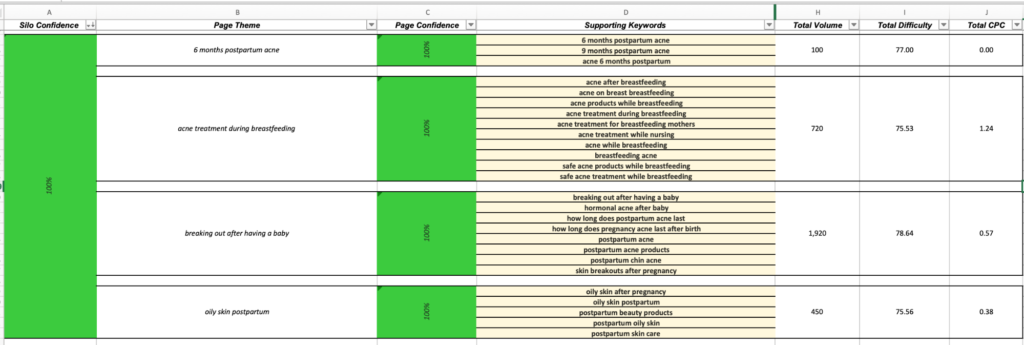
In the case of postpartum acne, KC segmented the Silos even further.
KC not only identified a broader Silo devoted to postpartum acne but categorized the underlying Page Themes by different aspects of hormonal changes experienced after childbirth.
The clusters related to ‘6 months postpartum acne’ and ‘acne treatment during breastfeeding’ are very specific.
In contrast, clusters related to ‘breaking out after having a baby’ and ‘oily skin postpartum’ are more general because they refer to the postpartum period as a whole rather than a specific timeframe or aspect of caring for a newborn baby.
All of the Page Themes are connected and should be interlinked. They also need to be separated into different pages rather than lumped together in one.
There is a commonality amongst the keyword clusters — but Google sees them differently.
Recognizing that Google views related keywords as unique is crucial when structuring your site and creating content for SEO.
For instance, not all women who are postpartum breastfeed…
Therefore, it may be wise to create a unique page for acne while breastfeeding and another page about oily skin postpartum and interlinking them within the silo of postpartum acne.
This insight wouldn’t be intuitive to someone who doesn’t have in-depth knowledge of skincare or hormonal changes.
Even without any subject matter knowledge, this is easily identifiable with Keyword Cupid.
SO MANY PRODUCTS!
Another challenging and time-consuming aspect of keyword research is understanding which specific brands and products address particular problems.
In a niche as saturated as the beauty industry, it’s almost impossible to keep everything straight.
The keyword list I uploaded has keywords related to probiotic skincare brands and some specific products those brands produce.
By analyzing the overlapping SERPs, Keyword Cupid separated the keywords related to the brand as a whole from the keywords related to a particular item.
For example, Tula is a very popular probiotic skincare brand with a wide range of products for almost any skincare concern you can think of.
One product Tula offers is a spot treatment designed to treat acne. KC groups keywords related to ‘tula spot treatment’ in a separate page theme from the other keywords related to ‘tula products for acne’.
Both Page Themes are contained within one silo — which includes all keywords related to treating acne with Tula — but are grouped into different Page Themes.
This is because the search intent is different for these keywords.
Keywords like ‘tula products for acne’, ‘tula acne clearing kit’, and ‘tula before and after acne’ relate to the overall condition of acne and clearing your entire face.
By contrast, acne spot treatment is formulated to treat a much smaller area or a specific blemish.
Keywords related to ‘tula products for acne’ target people with widespread breakouts, and keywords related to ‘tula spot treatment’ target those with the occasional blemish. Google reflects this difference in its search results — as KC illustrates below:

DR ROSHINI, WHO?
Another important distinction KC made is distinguishing the differing search intent for a brand spokesperson or influence vs. search intent for the brand they represent.
Dr. Roshini Raj is a Gastroenterologist and cofounder of Tula skincare. Although some of the keywords I uploaded relate to her work with probiotic skincare and Tula, several keywords were related to curiosity about her personally. Her many talk show appearances have made her a mini-celebrity.
KC created a silo that includes all of the keywords related to Dr. Raj, separated the Tula and skincare related keywords into one page theme, and those about her as a person into another page theme.
This grouping makes intuitive sense because people curious about her personally may not even be interested in probiotic skincare.
By making this distinction, KC lets you quickly decide which keywords are relevant to your target audience without requiring much manual research of your own.

ALL YOU NEED IS A STARTER KIT
Although I just highlighted Keyword Cupid’s separation of different skin issues, there is a notable exception in my results.
The KC algorithm mostly grouped keywords about ‘sets’ and ‘kits’ into their own Silos rather than combining them with other clusters related to the relevant skincare issue.
For instance, acne kits and anti-aging kits each have their own Silos or Page Themes.
Since most skin concerns require multiple products, many people want to buy ‘sets’ or ‘kits’ or ‘starter packs’ rather than invest in pricier individual items.
Keeping this in mind, it would make sense to create a page on “skincare sets” for each condition people seek to alleviate.


Practical Application for Keyword Cupid Data
Now that I’ve used KC’s results to distinguish intent, you may be wondering what to do with this newfound information.
The easiest way to use these clusters is to let it guide your site structure.
You can interlink pages targeting keywords in the same Silos because you know that Google returns overlapping results for these keywords — and, therefore, views these keywords as related to each other.
This strategy is a great way to prevent keyword cannibalization on your site.
You can also use these clustering results to create content outlines for you…
For example, if you wanted to write content about ‘thyroid dry skin remedies’, here are your H2s:
- Thyroid and Dry Skin on Face
- Treating Thyroid Dry Skin
- Thyroid Dry Skin Remedies
- Best Cream for Thyroid Dry Skin
- Best lotion for Hypothyroidism

Just hand the outline over to a content writer, and your job is almost done!
Typically you need to do quite a lot of manual sorting and organizing to outline a piece of content unless you have pre-existing knowledge about your topic.
With Keyword Cupid creating the outline above took me only a few minutes.
FINAL REMARKS
I didn’t discuss all 84 Silos Keyword Cupid created from my list.
For the sake of brevity, I highlighted some of the key findings to illustrate how you can use KC to streamline many of your existing processes.
There are many effective strategies to distinguish search intent between keywords…
But KC produced results comparable to those of seasoned researchers with minimal manual effort or topical knowledge.
KC’s results are non-biased because they rely solely on the results of Google to cluster the keywords. The algorithms don’t rely on any human-made parameters or guesses. Without human intervention, KC structured the clustering reports to be hierarchical and multidimensional.
KC’s structure does take some getting used to, but it’s extremely helpful in interlinking on your site because that’s how site structures are built.
If this case study was helpful to you and you’re interested in seeing what Keyword Cupid can do for your site, take advantage of our 7-Day Trial for only $1.
Additionally, our Ultimate Guide To Keyword Cupid further explains how to run a report end to end.
You may also email us at [email protected] with any additional questions or want to connect with the KC Team!
Or feel free to ask any questions in the comments and I’ll do my best to answer them.
[cta]
[author_bio image=”https://seobutler.com/wp-content/uploads/2020/12/Morgan-Devlin-Headshot-150×150-1.png” name=”MORGAN DEVLIN”]Morgan is a Statistician that has worked with a wide range of organizations from Digital Marketing firms to Fortune 500 companies. She specializes in practical applications of statistical models and data visualization consulting. Morgan is now a Quantitative Analyst for Keyword Cupid residing in New York City. [/author_bio]
2 thoughts on “Case Study: How To Structure Your Site Using Keyword Cupid”
Leave a Reply
You must be logged in to post a comment.
Hi Morgan,
Thanks very much for sharing this, very intriguing! Does KeywordCupid work in languages other than English too?
Regards,
Yannick
Hi Yannick,
Thanks for reading! Because KC works solely based on Google results, it works for any language. Take a look at our video on clustering in Greek!
https://www.youtube.com/watch?v=IIaPOm5cv78